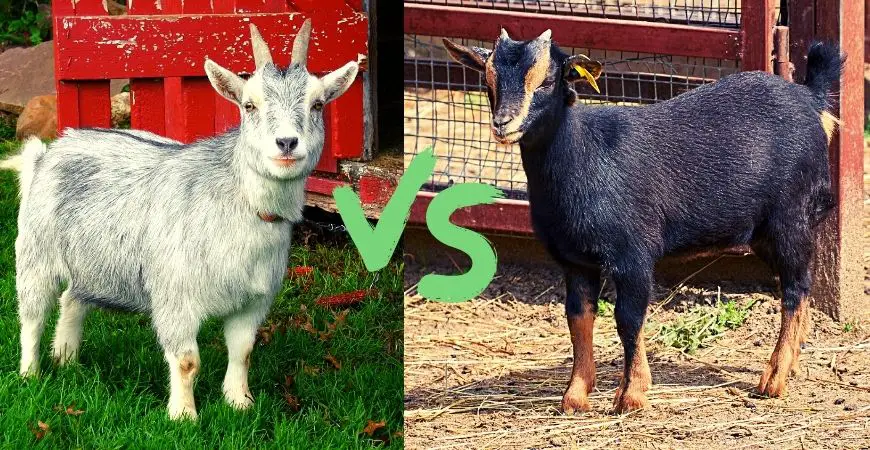There are many benefits to keeping miniature goats compared to their regular-sized counterparts. The two smallest and most popular breeds are the American Pygmy goat and the Nigerian Dwarf goat. People often confuse these two breeds because, at first glance, they are pretty similar. However, there are also some significant differences between the two breeds.
Pygmy goats have short, stocky stature with thick muscles because they have been bred for their meat. Nigerian Dwarfs have longer legs, a slenderer build, and a larger udder and teats because they have been bred for milk production. Pygmy goats are horned, whereas Nigerian goats can be hornless.
Miniature goats are playful, inquisitive, and downright adorable. They make lovely pets or companion animals and produce delicious milk you can use to make cheese.
You do not need a farm or homestead to keep goats. Miniature breeds can be kept in your urban backyard. It is essential to learn about the different breeds so that you choose the right goat for you.
Origin of American Pygmy and Nigerian Dwarf Goats

West Africa is home to many breeds of achondroplastic goats. That is goats with genetic dwarfism. Between 1930 and 1960, the United States imported these goats to exhibit in zoos, for use in medical research, and for breeding as companion animals.
Breeding led to two distinct varieties of dwarf goats developing – ones with a stocky, solid build and others with a more delicate frame. In 1975, the two groups were recognized as separate breeds, the former being called the American Pygmy goat and the latter the Nigerian Dwarf goat.
American Pygmy Goats
American Pygmy goats grow to a weight of between 25 and 40kg (55-88 lbs) and a height of 40 to 50cm (16-20 inches) at their withers. They have a heavy bone structure and are thickly muscled.
They are the smallest goat breed that has been developed for their meat. There are seven different color varieties, from plain black to grey, brown, and caramel.
Nigerian Dwarf Goats
Nigerian Dwarf goats stand 40-60cm (17-24 inches) tall at their withers and weigh about 35 kg (75 lbs) when full-grown. With a smaller, more delicate stature, they closely resemble other dairy goat breeds.
Nigerian Dwarfs were bred as dairy goats or companion animals and are used as a dual-purpose meat and dairy breed. They come in many different color varieties and are often multi-colored. Their fur ranges from gold to chocolate, black, and white.
The Difference Between American Pygmy and Nigerian Dwarf Goats
People that are unfamiliar with goats sometimes confuse American Pygmy and Nigerian Dwarf goats, but there are some notable differences between the two breeds:
Similarities Between American Pygmy and Nigerian Dwarf Goats
These miniature goat breeds also share many characteristics.
How Long Do Miniature Goats Live?
Regular-sized goats have a lifespan of 15 to 18 years. Miniature goats have slightly shorter lifespans. Nigerian Dwarf and American Pygmy goats both live to be around 8 to 12 years old if they are well taken care of. Goats need to be vaccinated and treated for intestinal parasites.
Males generally do not live as long as females. This is due to the metabolic stress that coming into heat and rutting has on their bodies. Typically, the more times a goat mates in its lifespan, the shorter it will live.
Females sometimes die due to birth complications when they are older than 10 years. Does who are retired from breeding at a younger age have a higher life expectancy.
Advantages of Keeping Miniature Goats
Besides being unbelievably cute and loads of fun to watch, miniature goats are valuable livestock to keep. There are several advantages to keeping them, compared to regular sized goats:
Disadvantages of Keeping Miniature Goats
The list of disadvantages is relatively short, and here they are:
What Do You Need to Keep Miniature Goats
Caring for miniature goats is simple once you get the hang of it. Ensure that you have the following set up before bringing your new goats home for the first time:
Shelter
Goats need a three-sided structure to get out of the wind and rain. They hate getting wet, so make sure they have a cozy place to keep dry. You can keep them in a shed at night if you have one, but a doghouse or a makeshift shelter out of scrap wood will work perfectly fine. Miniature goats need about 10 square feet of indoor space each.
Fenced enclosure
Each goat needs about 200 square feet of space outside. As mentioned earlier, miniature goats are really good at escaping, so you will need to fence them in. The fence needs to be at least 4 feet tall, but many miniature goat owners recommend a 6-foot fence. The best type of fencing to use is chain link or electric fencing. Keep in mind, if a cat can escape, so can a goat!
Climbing structures
Goats have an irresistible urge to jump around and climb onto things. Place old wooden tables, cable spools, bales of hay, or custom-built platforms for them to play on. If they do not have objects to climb onto, they will find one and may end up breaking stuff. However, make sure the platforms are far away from the fence so that they do not jump out.
Feeding Miniature Goats
In the wild, goats are browsers rather than grazers, so you will need to provide them with browsing pasture or hay. Many urban goat owners do not have access to pasture, so they feed their goats hay in a manger or a hanging net.
For milk production, goats need a good source of protein, or they will lose weight and condition. Alfalfa is very rich in protein and is a great species to grow for goats.
Besides their basic nutritional needs, goats also require certain micronutrients like selenium and copper in their diet. One can buy nutritional supplements from a feed store. To maintain their digestive tract, they should also be given baking soda.
Caring for Nigerian Dwarf and American Pygmy Goats
One of the many benefits of Nigerian Dwarf and American Pygmy goats is that they have better immunity against diseases. However, they do still require some basic medical care to keep them healthy.
Intestinal parasites, like worms, can be a huge problem for goats. The FAMACHA Scoring System was developed as a way to monitor goats’ health and determine when they need to be dewormed.
Deworming on a regular schedule, for example, every six months, is not a good idea, as many parasites can develop resistance to deworming medication. Instead, monitor your goat herd and only deworm them when it is necessary. Remember to keep detailed records of all medications or treatments you administer to your goats.
Like other hooved animals, for example, horses and cows, goats’ hooves grow faster than they can wear them down. Therefore, goats need to have their hooves trimmed every three to four months. This is relatively simple to do using a hoof trimming tool.
Breeding Miniature Goats
Both American Pygmy and Nigerian Dwarf goats reach sexual maturity at about 2 months of age. However, one should wait until three months before breeding for males and until eight months for females.
If you plan on regularly breeding miniature goats, you should have their blood tested on a yearly basis to ensure safe breeding.
Goats require slightly different care when they are being bred. Does need to be fed grain when they are pregnant and during lactation to ensure that they do not lose physical condition .
However, with the help and guidance of your local vet, you should easily be able to produce many adorable little kids without compromising health of your miniature goats.
Conclusion
American Pygmy and Nigerian Dwarf goats were both developed from West African dwarf goats between 1930 and 1960. They were imported to the United States to exhibit in zoos but quickly fell into the hands of private collectors. These pint-sized, bouncy little goats are absolutely adorable.
Nowadays, keeping miniature goats is very popular amongst homesteaders. They are thickly muscled and make excellent quality meat. Miniature goats also produce milk that is high in butterfat, making it sweet and creamy. Goat milk is used for making cheese, yogurt, and soap .
Those unfamiliar with goats’ breeds often confuse American Pygmy and the Nigerian Dwarf or use the names interchangeably, but there are several significant differences between the these two breeds, as summarized in the table below:
Header | American Pygmy | Nigerian Dwarf |
|---|---|---|
Body Shape | Barrel-shaped, stocky, short-legged | Delicate, similar to other dairy goat breeds |
Body Size | 40-50cm (16-20”), 25-40kg (55-88lbs) | 40-60cm (17-24”), 35 kg (75lbs) |
Breeding | Polyestrous | Once in a Year |
Eyes Color | Brown | Blue or Brown |
Horns | Male and females horned | Can be hornless or horned |
Popular Use | Meat or kept as a pet | Dairy, Meat, Pet |
There are many advantages to keeping miniature goats compared to regular-sized goats. They require less indoor and outdoor space, making them the perfect breed for urban homesteaders. They require far less food than regular-sized goats. Miniature goats are easier to handle and transport than regular-sized goats. They are the perfect option for first-time goat owners.
Sources:
